|
September 2010
Photographers Resource -
Monthly
Edition 81 |
Then and Now Photography
and Photographing Old Prints |
|
|
|
In This Issue:-
Coming to the end of the summer and tourist
season in the UK, amid travel companies going bust, airlines and airports with
industrial action and less than ideal weather in very many places, you might be
tempted to wonder why we bother. While some like to go and lay in the sun, until
approaching medium rare, others of us who like to get experiences, learn, see, explore and fact find, try to keep out of most of it, drive around in air
conditioned vehicles and stay in air conditioned hotels maintaining temperature,
well very near to home, in the later part of an English summer. So the UK in
September is perhaps the ideal, not too hot, many of the schools starting back
and therefore numbers of people thinning out, and even at weekends we find many
psychologically have passed the holiday period, and there are few crowds and so
much to see. We are fortunate in that we
live in a country with so much to see, explore and enjoy, if you were to
visit a couple of places or things a week you would have difficulty getting
to see everything available in a lifetime. Joining organisations like the
National Trust, English Heritage, and the Scottish and Welsh equivalents,
the Historic Houses Association, Wetland and Wildlife Trust, RSPB, and
others, each for one year before moving on to another, can give a large
number of places each year with no entry charges, and on top of this there are
many National museums and very many places that you can visit that have no entry
charges. See
Controlling Costs
 under reference, for more ideas on
getting to explore more at very low cost. under reference, for more ideas on
getting to explore more at very low cost.
September is a month where historically many
of us think about doing an evening course or joining a local organisation,
and some do it, well at least for a few weeks. Its also a time when
many stop and think about the hobbies or interests they are going to pursue
over the winter months, and younger people start making their Christmas
present wish lists. Others say if only I had the time I would.....
or I wish I had..... but now I am too old, infirm, busy, idle,
have too many commitments, or some other collection of reasons.
Perhaps I am no different if only I had more time I would write more, I have
at least half a dozen novels thought out, could get around to editing more photos,
index my photo collection, do more drawing and painting..... and this is only
the beginning of the list. Given
that you are probably the same, many things you would like to do if only...., you may not feel you have the time for more, although there
is an old saying that 'if you want something done you should give the task
to a busy man', and to be politically correct we should now add 'or woman.'
So the interest I want to introduce you to is
Time Travel. No I'm not marketing a time machine, although having one might
allow you to get more done, but instead looking at the exploration of
changes that have occurred over time.
As a photographer I am looking at this from a
photographic interest viewpoint, but people who don't want to take photos
can enjoy this interest just as much, and its something that photographers
will find other members of the family are happy to become involved in and
others will love to see your photographic results. The interest can also be
called comparative photography, and is a valid branch of photography with
commercial, legal and defence applications, or from the time travel
perspective 'then and now' photography.
|
|
Lets
explain how this newsletter and resource works
Each month we have a newsletter or
magazine and this comes out on or about the 1st of the month. The
newsletter also links to a number of new articles, tables of information
and detailed location guides amongst other things.
One of the most popular features is a
monthly diary covering interesting and unusual things on, around the UK
in the two months ahead.
Everything that appears, or ever has,
is indexed in a number of ways, alphabetically, by topic tree entry, by
county, and often linked into sections. Many of the sections have their
own front doors so people with other specific interests have access
through these doors to their area of interest.
You can also get back to see every
newsletter, over 80 of them.
Each article or location guide and some
others also have hyperlinks, flagged with symbols by them, telling you what it is and where it
goes, so
 means its an article (they connect together to tell a full story, so are like
parts of a jigsaw),
means its an article (they connect together to tell a full story, so are like
parts of a jigsaw),
 a list,
a list,
 a location guide or
a location guide or
 a featured location guide that you want to get your eyes on.
a featured location guide that you want to get your eyes on.
 is a route guide,
is a route guide,
 a
photo gallery, a
photo gallery,
 a map,
a map,
 a PDF
document, and the like. a PDF
document, and the like.
 means its one of our system pages, such as a section or index.
means its one of our system pages, such as a section or index.
The
 flag shows
its a link to an outside website and will always open in a new browser window. flag shows
its a link to an outside website and will always open in a new browser window.
We also have symbols that
tell you what is at a location, so when looking through an index or newsletter,
you know what is there without looking at each one, or us having to use a vast
amount of text. If you see a symbol you don't recognise putting your mouse
pointer over it, tells you its purpose or clicking on it, brings up the full
list of all symbols, in a new browser window, so you don't lose where you are
reading.
Many months we add major new topics and
develop these to be the best resource on that topic. If we were a
printed magazine we would be limited to the amount that would fit
between the advertisements, while being online we have no physical
limit, just time. So many of our topics are huge, many months we don't
add the contents of a magazine but the equivalent to several books. This
means that in many topics we have the most complete and largest amount
of information available, we have all
Lighthouses
 in use around
our coasts, every
windmill with sails in use around
our coasts, every
windmill with sails
 and most others where any major
remains exist are listed. We have every
stone circle, and most others where any major
remains exist are listed. We have every
stone circle, carved hill
feature,
carved hill
feature,
 all preservation
Railways,
all preservation
Railways,
 Living History
Living History
 museums, and major
sections on
Roman Britain museums, and major
sections on
Roman Britain
 , waterfalls, coastal, thousands of
Gardens , waterfalls, coastal, thousands of
Gardens and large
Historic Houses, and large
Historic Houses,
 , many
Castles , many
Castles
 , all the
Abbeys , all the
Abbeys
 and major
religious buildings and more. We also have information on various
wildlife and some plants. I am sure you get the idea, look through back
copies or the topic or sections indexes to see the full range. Each
month more gets added and as its all indexed multiple ways you can find
it. We have covered a large number of photographic skills,
techniques and special interests all defined and explained with projects
and more. and major
religious buildings and more. We also have information on various
wildlife and some plants. I am sure you get the idea, look through back
copies or the topic or sections indexes to see the full range. Each
month more gets added and as its all indexed multiple ways you can find
it. We have covered a large number of photographic skills,
techniques and special interests all defined and explained with projects
and more.
All of this makes a huge resource, and
much of it is of general interest to everyone who likes to get out and
explore Britain as well as photographers.
All you need to do is to remember once
a month to come back and see what's new and when any question arises to
consider coming to see what we have in our resources available. Its all
FREE, there is no registration or other requirements and advertising is
kept to an absolute minimum and never in the centre of articles or
other information. There are no paid staff and we cover our costs by you
occasionally clicking on an advert and from this we get a few pence. |
|
|
|
|
Feature
Then and Now or Comparative
Photography
If we took a photo and then came back in
a year or two and took a photo from the same location some things would have
changed, councils do this from the air to spot who has built what without
planning permission, and its done with spy planes to monitor military
installations, its also used in the very short term a few fractions of a second
or several minutes to automatically issue revenue charges for people speeding.
See
Comparative photography and speed cameras.

Then
and Now photography,
 we can take a photo taken some time back by us or others, perhaps published
prints or paintings and go and find the location the photographer or artist
stood, to see how it has changed. In your lifetime you will be able to
think back at just how many things have changed, but using other material we can
go back further, travelling back in time. We can go back just over 100 years and
see around 1,500 colour photos of Britain in around 1905, or we could travel back
in time around 200 years and look at the 400 or more images created by the
artist John Constable, some as sketches and some as painting as tall as you or
larger. we can take a photo taken some time back by us or others, perhaps published
prints or paintings and go and find the location the photographer or artist
stood, to see how it has changed. In your lifetime you will be able to
think back at just how many things have changed, but using other material we can
go back further, travelling back in time. We can go back just over 100 years and
see around 1,500 colour photos of Britain in around 1905, or we could travel back
in time around 200 years and look at the 400 or more images created by the
artist John Constable, some as sketches and some as painting as tall as you or
larger.
Old photographs are available for just about
any area or topic, be it as Photochromes, old postcards,
prints in your local museum or library, local history centre or from one of the
commercial firms offering them or from a range of books now produced with old
photos. Within your family others may have old photos of personal interest to you
as well. See where
to get old prints from
 to look at this further.
to look at this further.
Photochromes are a specific interest of mine
and I have collected 1,500 covering the UK, some as scans or copies made by others,
but I also have a large number of originals. We previously had a short
introduction to Photochromes but I have just completely rewritten and extended
it, see
an introduction to Photochromes.
 We also before had some of our Photochromes online and available to you, but
did not have Scotland, Wales or Ireland, I have completely redeveloped this sub
website to become a larger archive of images, and at the same time redesigned
and expanded the Photochrome section, it's now on our
NEW
Photo Archive
We also before had some of our Photochromes online and available to you, but
did not have Scotland, Wales or Ireland, I have completely redeveloped this sub
website to become a larger archive of images, and at the same time redesigned
and expanded the Photochrome section, it's now on our
NEW
Photo Archive
 website, available from the
locations menu, section menu and gallery sections. At the same time we have
included Scotland, Wales and Ireland as well as the English photos you had
available before, giving you the chance to see now all 1,500 or so images we have
to date.
website, available from the
locations menu, section menu and gallery sections. At the same time we have
included Scotland, Wales and Ireland as well as the English photos you had
available before, giving you the chance to see now all 1,500 or so images we have
to date.
I have in the last month also invested a day in
Derbyshire, looking at the places the Photochromes were taken and then visiting
and looking to see what can be seen now.
Derbyshire Then and Now Locations  is
a table that shows 6 photos I went to see and links to photos and details on 12
others. is
a table that shows 6 photos I went to see and links to photos and details on 12
others.
|
|
In practice a lot of the day was spent also looking around two large
houses, and you have only the 'then and now' details available now, although we
will write these locations up fully at some point. This table links to 6 'then and now'
location pages allowing you to see the old photos as well as what I found and some
photos taken on my visit. |
|
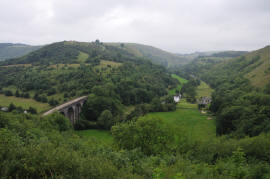 |
|

 Monsal Head 2010
Monsal Head 2010
Monsal Dale, Bakewell, Derbyshire
|
|
Around 15 year ago I did a series of then and
now photos running over many months for a national magazine, and I spent another
day, within the last month, revisiting 7 places in Somerset one of which I had 2
'then and now's' and another 4. As I have photos taken 15 years ago, I have 3
generations, the then, then 15 years ago, and the now for these. These are
linked in
Somerset Then and Now locations,  linking to 7 location pages. linking to 7 location pages.
There are a few more locations defined with
then and now photos at
Then and
Now Locations  linked to
location guides. linked to
location guides.
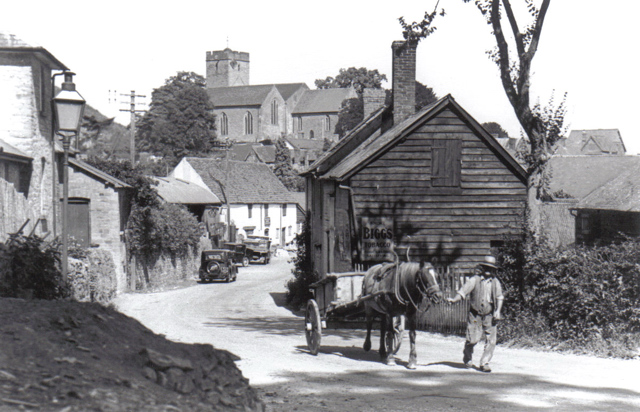
Wigmore Then & Now, Herefordshire
Last year and earlier this year, I visited again
some of the locations that the artist and landscape painter John Constable used
in his paintings, the locations of some are well known while others are more of a
time detective game to work out. With art, rather than photographs, the
artist may have used some artistic licence, but in most cases John Constable
painted what he saw and therefore we have the opportunity to go and try and find
it again, now approaching 200 years later. I have visited quite a lot of his
painting locations, and have not so far had time to write them all up, but I
have started producing the table
John
Constables Painting Locations Then and Now
 listing some of his works, and have produced, so far, 16 location guides for paintings or groups of
paintings, plus a feature guide on
Flatford Mill
listing some of his works, and have produced, so far, 16 location guides for paintings or groups of
paintings, plus a feature guide on
Flatford Mill
 the centrepiece of Constable Country and around which many of his paintings were
based. I could add quite a few more now, and have a list of other places I still
want to explore. The article
John
Constable Painting Locations
the centrepiece of Constable Country and around which many of his paintings were
based. I could add quite a few more now, and have a list of other places I still
want to explore. The article
John
Constable Painting Locations
 explains more about the artist and his life story, plus shows a few of his
works. explains more about the artist and his life story, plus shows a few of his
works.
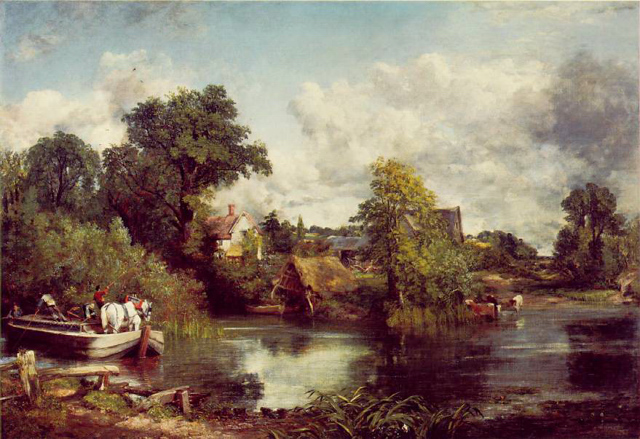
The White Horse Then & Now, Flatford, Suffolk

by John Constable
If you decide to join in this interest and
track down some locations yourself then you will find the articles
Then
and Now Photography,
 Where to Get Old Prints From,
Where to Get Old Prints From,
 and
How to
Find Locations and
How to
Find Locations
 helpful. The last of these looks at the tricks, or should we call them skills,
that allow you to work out where the photo is of and where the photographer or
artist was standing. helpful. The last of these looks at the tricks, or should we call them skills,
that allow you to work out where the photo is of and where the photographer or
artist was standing.
We have also added a couple of extra reference
pages that may be helpful
Record Offices
 gives
details and links for most of the public record offices both representing
national and county archives,
Where to Get Old Prints From gives
details and links for most of the public record offices both representing
national and county archives,
Where to Get Old Prints From
 suggests more sources. The second reference page is
County
Code List, suggests more sources. The second reference page is
County
Code List,  this is the three letter abbreviations used by family history and local history
enthusiasts, as well as us, to identify static ceremonial counties and information
relating to these county codes and their use is further explained in the article
County
Codes. this is the three letter abbreviations used by family history and local history
enthusiasts, as well as us, to identify static ceremonial counties and information
relating to these county codes and their use is further explained in the article
County
Codes.

An article
Local
History
 takes an introductory look at this interest, and added at this time as it's
relevant to finding old photographs, but we intend to expand on this in the future. takes an introductory look at this interest, and added at this time as it's
relevant to finding old photographs, but we intend to expand on this in the future.
|
|
|
Photographic Feature
How to Photograph Old
Photographs, Prints and Paintings
The article
How to
Photograph Old Prints
 looks at how to go about producing photographs of this type of material, and
overcoming each of the problem areas associated with it.
looks at how to go about producing photographs of this type of material, and
overcoming each of the problem areas associated with it.
In practice for 'then and now' photographs, we have
discussed above, you can often download copies of images or use a scanner to
produce an image, if its only required as a low resolution image for use on the
internet or the like. Producing a good photograph, with the
colour balance
 right and all problems overcome would produce a far better result than scanning.
right and all problems overcome would produce a far better result than scanning.
A lot of the downloadable material you will
discover is not ideal, I have for example art copies of John Constables
paintings, plus a few quality reproductions produced by artist, and the detail
and colour in these is far better than the public domain images available. The
public domain images serve the purpose I am using them for, of comparing
locations, and the images I have used throughout the location guides added this
month I used either scans or existing files, rather than re-photographing these,
as the images resolutions being produced in these were not large, but if I
wanted to produce a photo for an exhibition or similar use I would then
re-photograph originals where I could.
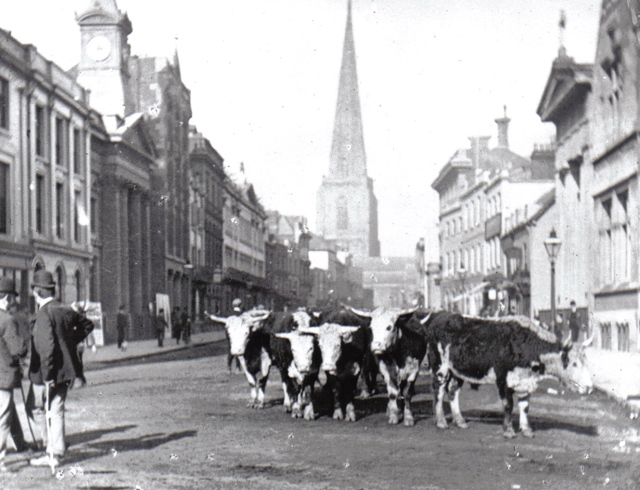
Market Day Hereford Then & Now, Herefordshire

When you look at old prints, you will discover
different technology, surfaces and techniques. Some will be more of challenge to
photograph than others. Photography was not a big bang invention by an
individual but a slow process where the development or discoveries of one person
was built on by another, and some times slowed down, as technological
developments are today, by people taking out patents. Some but not all of these
small steps is shown in
A
Photography Timeline
 I
have produced starting from 600BC and coming up until recent time. I
have produced starting from 600BC and coming up until recent time.
We are starting to cover a little more of the
history of photography, and cameras but rather than this being a feature subject
we decided to add it a little at a time, looking at collections, cameras,
techniques, how to identify these, and items like image sizes and material used.
So the timeline is the first part of this, but also interesting when we want to
re-photograph old prints, as its the stating point to have some idea as to the
age of the print. The timeline also gives you a good idea of what type of
photos are available at what time point and where you run back before
photography.
We plan to come back to photographing prints
in a while when we look at re-photographing and restoring images with examples
and projects as well.
Changes - What would you like ?
Much of what we have done in this newsletter and
linked resource has worked well, if you are not familiar with what we have
available see the column near the top of this page on the right for a general
description. Some areas we know we would like to improve and we have so many
topics and places we would love to cover.
We are currently reviewing our design and method
we use to produce it, as well as servers and other arrangements. We want to be
able to get the volume throughput we get now, but perhaps could do with using some
later development tool resources, maybe benefits other programming languages
offer, and maybe a later typeface would be clearer. However we are aware of the
need to keep the site at a level where older browsers can read it. Although
ideally we would very much like to hear from any of you who have any requests or
suggestions. You can suggest things, even if you don't know how it could be
possibly achieved.
We are also considering creating a special simpler
smaller version of pages that would be usable on a mobile phone browser, so
minimal text, small photos but maintain much of the location grid information.
What do you think, would you use this ?
Another area under review is how we fund this
resource,
perhaps we should have more advertisements, perhaps put a donation button on
every page, perhaps look for sponsorship. While its a non commercial site, so we
don't need to generate profits, we are limited in what we do and would just love
to be able to take on more large projects. Maybe you have ideas on this.
Perhaps you would like to become involved in some
way, if so tell us how, and please feel free to suggest anything at all.
We won't be able to do everything people suggest,
partly through funding limits, partly time and the need to keep the design
constant enough that the hundreds of thousands of people who have already been
enjoying our content still feels its a site they are happy to use. Its a
site built principally for people in the UK, although we welcome the readers
we have from around the world and on a typical day have readers from around 60
countries.
|
|
The Photographers Diary
|
The October diary is now in the 'next month' slot
with September moved to 'this month'. Both months have a lot of opportunities for
everyone. Some highlights that are of particular interest are:-
The start of September sees probably Europe's
largest steam fair get underway near Blandford in Dorset. The Great Dorset
Steam Fair runs for 5 days from the 1st to the 5th of September. In this
large site its arenas and display areas showcase
Steam engines and vehicles
of all types, Fairground Organs, vintage cars, bikes and commercial vehicles,
tractor pulling, heavy horses, vintage collections and occupations, rural
crafts, dancing shows, fairground, pipe bands, nightlife and a music festival. A
must see for steam enthusiasts, but also a great opportunity for photographers
to capture images of these giants of steam operational in demonstration areas or
in the arenas. |
|
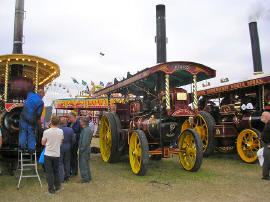 |
|
 Great Dorset Steam Fair
Great Dorset Steam Fair
|
|
|
|
The 2nd sees the start of the
3 day Burghley Horse Trials in Lincolnshire, and on the 9th the 3 day
Blenheim Palace International Horse Trials take place at Blenheim Palace in
Oxfordshire. Staying with the horsey theme the National Carriage Driving
Championships, where the skill of horse handling with a carriage are
displayed over the 3 days at Windsor Great Park in Berkshire, using the back
drop of Windsor Castle for this prestigious event. If you want to see the heavy
horse in action then check out some of the Ploughing Matches taking place this
month around the country including in West Felton, Shropshire, where the
Cruckton & District Ploughing and Hedging event takes place on the 25th,
watch out for the Human Ploughing match, where a team of 16 people dress up, 1
as the the ploughman the remainder as the 'horse power' and they plough an area
of land in 15 minutes. |
Heritage
Open Days. Every year our heritage is celebrated with
a weekend of FREE access to many of our historic buildings, including some
properties that are normally closed to the public. This year the event runs from
the 9th to 12th and nearly 4,000 properties in England are taking part. To find
a property near you check out the
Heritage Open Days
 website and search for
something to explore in your area. On the same theme Scotland also has it's own
Doors Open Days, which take place over the 4 weekends of September
starting this weekend on the 4th.
Cities, towns, villages and countryside from
the Highlands to the Lowlands are involved, opening up historic and contemporary
buildings that are not normally accessible to the public or free to enter. The
highlights this year include a top secret WW2 bunker in Inverness, a lighthouse
on Shetland, and caves in Edinburgh's South Bridge. As part of the European
Heritage Days, Wales' Open Doors Days also take place throughout
September, more can be found out at
their website
website and search for
something to explore in your area. On the same theme Scotland also has it's own
Doors Open Days, which take place over the 4 weekends of September
starting this weekend on the 4th.
Cities, towns, villages and countryside from
the Highlands to the Lowlands are involved, opening up historic and contemporary
buildings that are not normally accessible to the public or free to enter. The
highlights this year include a top secret WW2 bunker in Inverness, a lighthouse
on Shetland, and caves in Edinburgh's South Bridge. As part of the European
Heritage Days, Wales' Open Doors Days also take place throughout
September, more can be found out at
their website
 where you
can search their database to find something to visit.
The 2010 programme has nearly 300 opportunities to visit FREE of charge heritage
sites and take part in activities whilst exploring the history and architecture
of Wales. See their
website where you
can search their database to find something to visit.
The 2010 programme has nearly 300 opportunities to visit FREE of charge heritage
sites and take part in activities whilst exploring the history and architecture
of Wales. See their
website
 for more details and to
find somewhere to visit. Also if you live a London a similar event,
which celebrates London's architecture, is taking place with the annual Open
House London event. Hundreds of buildings of all types and periods open up
their doors for FREE during the weekend of 18th and 19th, visit
Open House London
for more details and to
find somewhere to visit. Also if you live a London a similar event,
which celebrates London's architecture, is taking place with the annual Open
House London event. Hundreds of buildings of all types and periods open up
their doors for FREE during the weekend of 18th and 19th, visit
Open House London
 for more details.
for more details.
|
|
Blackpool Illuminations.
The 3rd-5th of this month is the big switch on weekend for this years Blackpool
Illuminations, which is being switched on by Robbie Williams. Blackpool has been
bringing this spectacular show each year since 1879, with the streets of
Blackpool and it's trams being lit up during the long autumn nights. Each year
new additions are added along the drive and this year is no different, but not
unveiled until switch on night, with last year a new Dr Who section added. At
the Bispham Cliffs end the tableaux's are always a highlight especially for
children, two of this years themes for these being Dino Doom, with dinosaurs and
Goulish History depicting the history and heritage of Blackpool complete with
its very own Gouls. For photographers a walk along the route opens up loads of
night time photography
 and low light photography opportunities as well as
being able to experiment with slow shutter speeds for
and low light photography opportunities as well as
being able to experiment with slow shutter speeds for
|
movement effects of the
colourful lighted trams, or the fairgrounds on the piers and within the
Blackpool Pleasure Beach. See our location guide for
Blackpool Illuminations
 to find out what we were
able to capture back on a visit in 2008. We also have the following articles
which may help you with some of the techniques you can employ to get those good
shots.
to find out what we were
able to capture back on a visit in 2008. We also have the following articles
which may help you with some of the techniques you can employ to get those good
shots.
They are:
Photographing carnivals with lights

Photographing fun fairs

Photographing fireworks

.
|
These articles are also going
to be useful towards the end of the month and into October when we start to see
some of the many annual illuminated carnivals take place. There will be more
details on these in next months issue.
If you're looking for
something a bit more unusual then you could take a look at some of these:-
-
Sowerby Bridge Rushbearing event on the weekend of 4th and 5th
September in Sowerby Bridge, Yorkshire, where a 16 foot high rushcart is
pulled by 60 local men in clogs visiting churches and a few ale houses in the
local area.
-
Abbots Bromley Horn Dance on the 6th September takes to the streets of
Abbots Bromley in Staffordshire and 12 dancers carry reindeer antlers, and a
hobby horse travel about 10 miles to different locations through the village
and surrounding farms and pubs.
-
World Black Pudding Throwing Championships in Ramsbottom, Lancashire on
the 12th where they throw black puddings wrapped in ladies tights at a
collection of Yorkshire puddings on a plinth 20 feet up.
-
If you are in Scotland you could take a look at the World Stone Skimming
Championships on Easdale Island near Oban on the 26th.
|
|
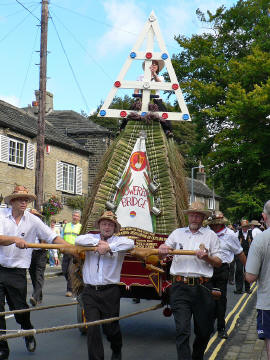 |
|
 Sowerby Rushcart
Sowerby Rushcart
|
|
This month sees the last of
the majority of the annual airborne events, not many of these events take place
during the winter months, for obvious reasons. However if you want to get in a
couple more before the end of the season then take a look in the diary for the
Battle of Britain Air Show on the 4th and 5th September at Duxford. Or in
the middle of the month another Battle of Britain Airshow this time at the
Cotswold Airport at Kemble in Gloucestershire. If you live or on holiday in
Northern Ireland then a visit on the weekend of the 4th and 5th, to West Bay
Beach in Portrush will find the skies filled with Red Arrows, wing walkers,
helicopter displays, parachute display teams and various other military and
civilian aircraft for two days at the Northern Ireland International Air Show.
If you want to see some air
activity but don't want the noise and scale of the military airshow then you
could pop a long to the Bristol Kite festival on the 4th and 5th, to see
large scale kites take to the skies or venture a little further southwest to
Tavistock in Devon and you could visit the West Country Balloon Fiesta on
the same weekend.
|
|
On water you could go to Devon and watch the
finals of the Offshore Powerboat Racing Championships on the 10th, or
pop along the to the Southampton Boat Show to see some spectacular
boats. The Salford Quays in Manchester is host to Zapcat Racing on the
18th and on the 25th in London The Great River Race takes place with
over 200 different rowing boats race each other along the River Thames,
including teams from around the world and some in fancy dress.
So as you can see there is still a lot still
going on in the UK during the September of all different types of activities
and plenty for you to get out and photograph. |
|
|
|
Wildlife Photography In
September September 1st is National Zoo Awareness Day, so take a
visit to your local Zoo and see what they are doing to make life better for the
animals they look after. Zoos also allow those who do not travel abroad to get
the opportunity to see animals from around the world. However we have plenty of
wildlife in UK that you can visit both in zoos, wildlife parks and by going out
into the countryside, my also get to see in the wild.
If you would rather
explore part of our vast coastline, you could take part in the annual Beach
Watch Big Weekend on the 18th and take part in recording what is happening on UK shores.
Oystercatchers with their
distinct black and white plumage and characteristic long orange beaks. Geese,
including Canada Geese will start to appear in their characteristic 'V'
formation in the skies as they head for our watering holes.
| For our native birds the colourful
Goldfinches can be seen on the side of our roadways as they flock to teasel
heads to get at their seeds before they ripen. Of our summer visitors
Swallows, Swifts and House Martins will be taking their leave of us and
retuning to their winter grounds, but they'll be back next year ready to
have a new brood. In our woodlands
you may have already noticed that the leaves on some of our trees are
starting to loose their vibrant green colour, and are starting to put on
their autumn coats of gold's, yellows and orange. A walk in the woodlands
you will start to see evidence fungi as it is peak season for them,
varieties such as stinkhorn will not only be noticeable because of its large
shape, but also as its name |
|
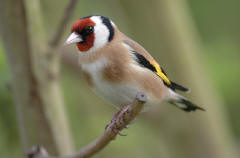 |
|
 Goldfinch
Goldfinch
|
|
suggests because of its
pungent smell. A walk in the countryside you cannot miss the giant puff ball,
usually grouped together on permanent pastures.
Many species of all types of wildlife including
insects, birds and mammals will be busy foraging for food to build up their
reserves ready for the coming winter months. The hedgehog will not only be
building up their fat reserves ready for hibernation, but some females may also
be giving birth for the second time this month. You may have noticed more small
flies this year, I know I have and as the nights start to draw in in the dusk of
the night you will see bats out making the most of this easy meal.
So don't forget the outdoors is just as good a
photo opportunity at this time of year as any other, and for some of our
visiting birds, it may be the last time you get to see and photography them for
this year. |
|
|
Summary of Articles Included
In This Issue |
|
County
Codes

Local
History

Comparative Photography and Speed Cameras

Then
and Now Photography

Where to Get Old Prints From

How to
Photograph Old Prints

How to
Find Locations

John
Constable Painting Locations

|
|
Lists Added This Issue |
|
County
Code List 
Record Offices

Photography Timeline

Then and
Now Locations

Derbyshire Then and Now Locations

Somerset Then and Now Locations

John
Constables Painting Locations Then and Now

|
|
Locations Guides Added This
Issue |
|
Boat
Building near Flatford Mill, Flatford, Suffolk

Bolsover Castle Then & Now, Bolsover, Derbyshire



Buxton Pump Room Then & Now, Buxton, Derbyshire


Buxton The Gardens Then & Now, Buxton, Derbyshire


Chilcompton PO Then & Now, Chilcompton, Somerset

Chilcompton - The Street Then & Now, Chilcompton, Somerset

Dedham Vale Then & Now, Dedham, Suffolk

The Cornfield Then & Now, nr
Flatford, Suffolk

The Cross Cheddar Then & Now, Cheddar, Somerset


Flatford Lock from the Mill House Then & Now,
Flatford, Suffolk

Flatford Mill,
Flatford, Suffolk

Flatford Mill Then & Now, Flatford, Suffolk

Flatford Mill from the Lock Then & Now, Flatford, Suffolk

Hadleigh Castle Then & Now, Hadleigh, Essex



Hardwick Old Hall Then & Now, nr Bolsover, Derbyshire



Hardwick Hall Then & Now, nr Bolsover, Derbyshire




The Hay Wain Then & Now, Flatford, Suffolk

The Leaping Horse Then & Now,
nr
Flatford, Suffolk

The Lock Then & Now, Flatford, Suffolk

Market Day Hereford Then & Now, Herefordshire

Marlborough High Street Then & Now, Wiltshire

Midsomer Norton High Street Then & Now, Somerset

The Mill Stream Then & Now, Flatford, Suffolk

Monsal Head Then & Now, Monsal Dale, Bakewell, Derbyshire

Radstock Then & Now, nr Bath, Somerset

The Square and St Johns Hunting Lodge Then & Now, Axbridge, Somerset



The Stour Valley And Dedham Church Then & Now, nr
Flatford, Suffolk

Two Boys Fishing Then & Now,
Flatford, Suffolk

The Valley Farm Then & Now, Flatford, Suffolk

View on the Stour near Dedham Then & Now, Flatford, Suffolk

Wells High Street Then & Now, Wells, Somerset

The White Horse Then & Now, Flatford, Suffolk

Wigmore Then & Now, Herefordshire
|